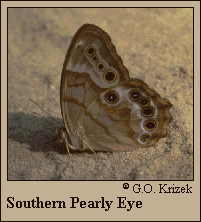 |
 

 |



Southern Pearly Eye (Enodia portlandia [Fabricius])
Wing span: 2 3/16 - 2 3/4 inches (5.6 -7 cm).
Identification: Antennal clubs are orange. Upperside is brown with dark eyespots at the margins. Underside is light brown; submarginal row of 4 spots (Florida females may have 5) on forewing is slightly curved and brown line inside this spot row is straight or zigzagged. Spots are encircled by diffuse white.
Life history: Males perch on tree trunks, sometimes head downward, to wait for females. Eggs are laid singly on or near the host plant; caterpillars feed on leaves. Older caterpillars hibernate.
Flight: Three broods from March-October.
Caterpillar hosts: Bamboo: giant cane (Arundinaria gigantea) and switch cane (A. tecta).
Adult food: Sap, rotting fruit, carrion, dung.
Habitat: Shady, damp woods near stream-fed swamps.
Range: Eastern Oklahoma and eastern Texas east through the southeastern United States.
Conservation: Its swamp forest habitats are gradually disappearing in the Southeast.
The Nature Conservancy Global Rank: G4 - Apparently secure globally, though it might be quite rare in parts of its range, especially at the periphery.
Management needs: Conserve and minimally manage all remaining habitats.
References:
Opler, P. A. and G. O. Krizek. 1984. Butterflies east of the Great Plains. Johns
Hopkins University Press, Baltimore. 294 pages, 54 color plates.
Opler, P. A. and V. Malikul. 1992. A field guide to eastern butterflies. Peterson
field guide #4. Houghton-Mifflin Co., Boston. 396 pages, 48 color plates.
Scott, J. A. 1986. The butterflies of North America. Stanford University Press,
Stanford, Calif. 583 pages, 64 color plates.
Author: Jane M. Struttmann

